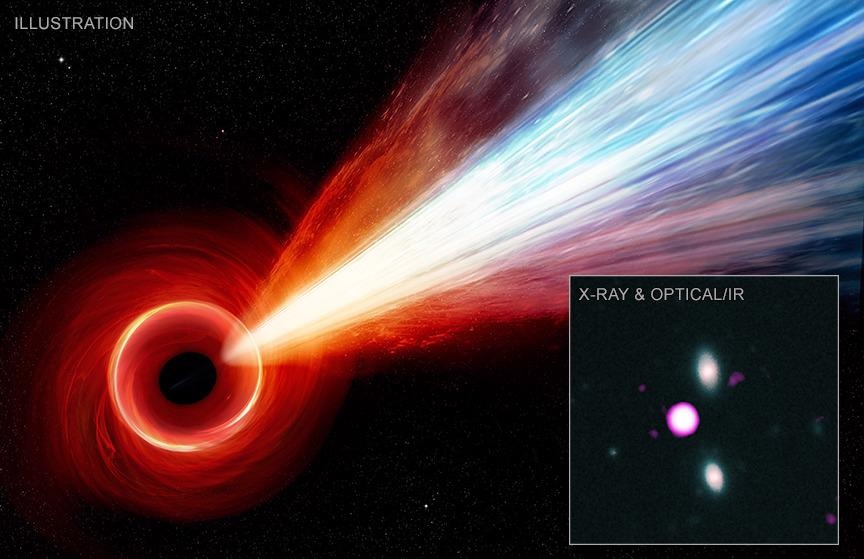Mar 10 2021
Astronomers used NASA’s Chandra X-ray Observatory to discover proof of the existence of an extremely long jet of particles discharged from a supermassive black hole in the early Universe.
 Image Credit: X-ray: NASA/CXO/JPL/T. Connor; Optical: Gemini/NOIRLab/NSF/AURA; Infrared: W.M. Keck Observatory; Illustration: NASA/CXC/M.Weiss.
Image Credit: X-ray: NASA/CXO/JPL/T. Connor; Optical: Gemini/NOIRLab/NSF/AURA; Infrared: W.M. Keck Observatory; Illustration: NASA/CXC/M.Weiss.
If verified and validated, this black hole would be the most faraway supermassive one with a jet detected in X-rays, discharged from a galaxy located nearly 12.7 billion light-years from Earth. It may offer an explanation for the formation of the biggest black holes at a very early time in the history of the Universe.
A quasar—a quickly expanding supermassive black hole—called PSO J352.4034-15.3373 (or PJ352-15) is the source of the jet. This quasar is located at the center of a young galaxy. It is among the two most powerful quasars identified using radio waves in the first billion years following the Big Bang and is nearly a billion times more enormous compared to the Sun.
One of the key questions in astronomy today is how supermassive black holes expand so fast to reach such a massive mass in this early epoch of the Universe.
Although black holes exhibit frightening reputation and strong gravity, they do not necessarily gobble everything that comes close to them. Materials that orbit around a black hole in a disk must lose energy and speed before they can fall farther inward to cross what is called the event horizon—the point of no return.
Magnetic fields can result in a braking effect on the disk when they power a jet, which is one main avenue for materials in the disk to lose their energy and, thus, improve the rate of expansion of black holes.
If a playground merry-go-round is moving too fast, it’s hard for a child to move towards the center, so someone or something needs to slow the ride down. “Around supermassive black holes, we think jets can take enough energy away so material can fall inward and the black hole can grow.
Thomas Connor, Study Lead Author, NASA’s Jet Propulsion Laboratory, Pasadena, California
Astronomers had to observe PJ352-15 for three days in total by leveraging the sharp vision of Chandra to identify proof for the X-ray jet. X-ray emission was observed nearly 160,000 light-years away from the quasar along the same direction as considerably shorter jets observed in radio waves. In contrast, the whole of the Milky Way extends to about 100,000 light-years.
PJ352-15 has broken two different astronomical records. Firstly, the longest jet observed earlier from the first billion years following the Big Bang was just around 5,000 light-years in length, corresponding to the radio observations of PJ352-15. Secondly, PJ352-15 is located nearly 300 million light-years farther than the most distant X-ray jet recorded ever.
The length of this jet is significant because it means that the supermassive black hole powering it has been growing for a considerable period of time. This result underscores how X-ray studies of distant quasars provide a critical way to study the growth of the most distant supermassive black holes.
Eduardo Bañados, Study Co-Author, Max Planck Institute for Astronomy, Heidelberg, Germany
The light spotted from this jet was emitted when the age of the Universe was just 0.98 billion years old—less than 1/10th of its current age. At this stage, the intensity of the cosmic microwave background radiation (CMB) remaining from the Big Bang was much more than what it is at present.
When the electrons contained in the jet fly away from the black hole at speeds close to that of light, they travel through and bump into photons constituting the CMB radiation, thus increasing the energy of the photons into the X-ray range to be detected by Chandra.
In such a case, the brightness of X-rays is considerably increased than radio waves. This accords with the observation that the large X-ray jet feature lacks any related radio emission.
Our result shows that X-ray observations can be one of the best ways to study quasars with jets in the early Universe. Or to put it another way, X-ray observations in the future may be the key to unlocking the secrets of our cosmic past.
Daniel Stern, Study Co-Author, NASA’s Jet Propulsion Laboratory
A paper elaborating on these results has been accepted for publication in The Astrophysical Journal and a preprint is available online.
The other co-authors of the study are Chris Carilli from NRAO, Socorro, New Mexico; Andrew Fabian from the University of Cambridge, UK; Emmanuel Momjian from NRAO; Sofía Rojas-Ruiz from MPIA; Roberto Decarli from INAF, Bologna, Italy; Emanuele Paolo Farina from the Max Planck Institute for Astrophysics, Garching, Germany; Chiara Mazzucchelli from ESO, Chile; Hannah P. Earnshaw from Caltech, Pasadena, California.